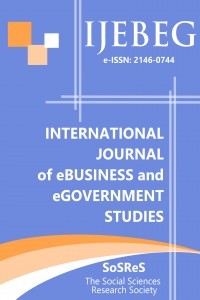AGRICULTURAL PRODUCTION IN SOUTH AFRICA: INFORMATION AND COMMUNICATION TECHNOLOGY (ICT) SPILLOVER
AGRICULTURAL PRODUCTION IN SOUTH AFRICA: INFORMATION AND COMMUNICATION TECHNOLOGY (ICT) SPILLOVER
Agricultural production, Land accessibility, Information and communication technology (ICT), General household survey Binary logit regression, South Africa,
___
- Acharya, R. & Basu, S. (2010). ICT and TFP growth: Intangible capital or productive externalities?, Industry Canada Working Paper 2010-1.
- Aldosari, F. et al., (2017). Journal of the Saudi Society of Agricultural Sciences Farmers ’ perceptions regarding the use of Information and Communication Technology ( ICT ) in Khyber Pakhtunkhwa , Northern Pakistan. Journal of the Saudi Society of Agricultural Sciences. Available at: http://dx.doi.org/10.1016/j.jssas.2017.05.004.
- Ali, J. & Kumar, S., (2011). International Journal of Information Management Information and communication technologies ( ICTs ) and farmers ’ decision-making across the agricultural supply chain. International Journal of Information Management, 31(2), pp.149–159. Available at:http://dx.doi.org/10.1016/j.ijinfomgt.2010.07.008.
- Bresnahan, T.F. & Trajtemberg, M., (1995). General Purpose Technologies: ‘Engines of growth’? Journal of Econometrics 65, pp. 83-108. 25
- Brynjolfsson E. & Hitt, L.M., (2000). Beyond computation: Information technology, organisational transformation and business performance. Journal of Economic Perspectives 14 (4), pp. 23-48.
- Brynjolfsson E. & Hitt, M., (2003). Computing productivity: Firm-level evidence, The Review of Economics and Statistics, 85(4), pp. 793-808.
- David, OO. 2013. “The Effect of Investment in Telecommunication on Economic Growth: Evidence from Nigeria”, International Journal of Advancements in Research & Technology, 2(1): 1 - 23.
- Draca, M., Sadun, R. & Van Reenen, J., (2007). ICT and Productivity. In Mansell, R., Avgerou, C., Quah, D., Silverstone, R. (Eds) Handbook of Information of Information and Communication Technologies, Oxford University Press.
- Food and Agriculture Organization, (2013). FAO Statistical Yearbook. Economic and Social Development Division, New York.
- Fu, X., Mohnen, P. & Zanello, G., (2018). Technological Forecasting & Social Change Innovation and productivity in formal and informal fi rms in Ghana. Technological Forecasting & Social Change, 131(August 2017), pp.315–325. Available at: https://doi.org/10.1016/j.techfore.2017.08.009.
- Grobler, WCJ. (2014). "Food insecure households coping strategies: The case of a low income neighbouhood in South Africa". Mediterranean Journal of Social Sciences, 5(13): 100-106
- Grobler, WCJ. (2015). "The determinants of urban food security: Insights from a low income neighbourhood in South Africa". Proceedings of the 15th International Academic Conference, Rome.
- Haskel, J., & Wallis, G., (2010). Public Support for Innovation, Intangible Investment and Productivity Growth in the UK Market Sector, IZA Discussion Papers 4772, Institute for the Study of Labor (IZA).
- Hudson, H.E. et al., (2017). Using radio and interactive ICTs to improve food security among smallholder farmers in Sub-Saharan Africa ☆. Telecommunications Policy, 41(7-8), pp.670–684. Available at: http://dx.doi.org/10.1016/j.telpol.2017.05.010.
- Jovanovic B., Rousseau P. L., (2005). General Purpose Technologies. In: Aghion, P., Durlauf, S. (Eds.), Handbook of economic growth, Elsevier, Amsterdam, vol. 1 ch. 18. 27
- Liao, H. et al., (2016). ICT as a general-purpose technology : The productivity of ICT in the United States revisited. , 36, pp.10–25.
- Lipsey, R G, K I Carlaw, & C T Bekar (2005). Economic Transformations: General Purpose Technologies and Economic Growth, Oxford University Press
- Mafizur, M., Arifeen, S. & Mamun, K., (2017). The effects of telephone infrastructure on farmers ’ agricultural outputs in China. Information Economics and Policy, 41, pp.88–95. Available at: https://doi.org/10.1016/j.infoecopol.2017.06.005.
- Moshiri, S., Simpson, W., (2011). Information technology and the changing workplace in Canada: firm-level evidence, Industrial and Corporate Change 20(6), pp. 1601-1636. Aldosari, F. et al., 2017. Journal of the Saudi Society of Agricultural Sciences Farmers ’ perceptions regarding the use of Information and Communication Technology ( ICT ) in Khyber Pakhtunkhwa , Northern Pakistan. Journal of the Saudi Society of Agricultural Sciences. Available at: http://dx.doi.org/10.1016/j.jssas.2017.05.004.
- Ochieng, S., Juma, J. & Jakinda, D., (2014). Impact of Information and Communication Technology-Based Market Information Services on Smallholder Farm Input Use and Productivity : The Case of Kenya. World Development, 64(104482), pp.311–321. Available at: http://dx.doi.org/10.1016/j.worlddev.2014.06.011.
- O’Mahony, M., Vecchi, M. , (2005). Quantifying the impact of ICT capital on growth: An heterogeneous dynamic panel approach, Economica 72, pp. 615-633.
- Romer, PM. (1990). Endogenous Technological Change, Journal of Political Economy, 98(5): 71–102.
- Rostow, WW. 1960. The Stages of Economic growth: A Non-Communist Manifesto, Cambridge, Cambridge University Press.
- Salampasis, M. & Theodoridis, A., (2013). Information and Communication Technology in Agricultural Development. Procedia Technology, 8(Haicta), pp.1–3. Available at: http://dx.doi.org/10.1016/j.protcy.2013.11.001.
- Schumpeter, JA. (1942). Capitalism, Socialism and Democracy, New York: Harper & Row, 3rd Edition
- Severgnini, B. (2011). Is ICT a Jack-in-the-Box? A counterfactual approach for identifying productivity spillovers, Copenhagen Business School, mimeo.
- Solow, RM. & Swan, TW. (1956). Economic Growth and Capital Accumulation, Economic Record 32 (63): 334-361.
- Statistics of South Africa [StatsSA], (2016). Community survey, 2016 – Agricultural households
- Stiroh, K. J., (2002). Are ICT Spillovers driving the New Economy?, Review of Income and Wealth, 48(1), pp. 33-57.
- Van Leeuwen, G., van der Wiel, H., (2003). Do ICT spillover matter: Evidence from Dutch firm-level data. CPB Discussion Paper No 26.
- Van Reenen, J., Bloom, N., Draca, M., Kretschmer, T., Sadun, R., (2010). The economic impact of ICT, Research report, SMART N. 2007/0020.
- Venturini, F. (2009). The long-run impact of ICT, Empirical Economics, 37(3), pp. 497-515,Venturini, F. (2011). The modern drivers of productivity, University of Perugia, mimeo.
- Zhang, Y., Wang, L. & Duan, Y., (2016). Agricultural information dissemination using ICTs : A review and analysis of information dissemination models in China. Information Processing in Agriculture, 3(1), pp.17–29. Available at: http://dx.doi.org/10.1016/j.inpa.2015.11.002.
- Başlangıç: 2009
- Yayıncı: Sosyal Bilimler Araştırmaları Derneği
Abdirashid Ali ADLE, Ömür AKDEMİR
OCCUPATIONAL HEALTH AND WORK SAFETY SYSTEMS IN COMPLIANCE WITH INDUSTRY 4.0: RESEARCH DIRECTIONS
A COMPARATIVE ANALYSIS OF E-GOVERNMENT SERVICES OF CROTIA, POLAND AND TURKEY
Zafer KILIÇ, Vildan ATEŞ, Aleksandar ERCEG, Sebastian JABLONSKI
AGRICULTURAL PRODUCTION IN SOUTH AFRICA: INFORMATION AND COMMUNICATION TECHNOLOGY (ICT) SPILLOVER
Oladipo Olalekan DAVİD, Wynand GROBLER
AN INVESTIGATION INTO SUSTAINABLE SUPPLY CHAIN MANAGEMENT PRACTICES IN A DEVELOPING COUNTRY
İsmail Erol, Meltem NURTANIŞ VELİOĞLU
WEBSITE USAGE IN DIGITAL PUBLIC RELATIONS – AN ANALYSIS OF IT COMPANIES IN TURKEY
